沉淀再出发:在python3中导入自定义的包
一、前言
在python中如果要使用自己的定义的包,还是有一些需要注意的事项的,这里简单记录一下。
二、在python3中导入自定义的包
2.1、什么是模块、包、库?
模块:就是.py文件,里面定义了一些函数和变量,需要的时候就可以导入这些模块。
包:在模块之上的概念,为了方便管理而将文件进行打包。包目录下第一个文件便是 __init__.py,然后是一些模块文件和子目录,假如子目录中也有 __init__.py,那么它就是这个包的子包了。
库:具有相关功能模块的集合。这也是Python的一大特色之一,即具有强大的标准库、第三方库以及自定义模块。标准库就是下载安装的python里那些自带的模块,要注意的是,里面有一些模块是看不到的比如像sys模块,这与linux下的cd命令看不到是一样的情况。第三方库是由其他的第三方机构,发布的具有特定功能的模块。自定义模块是用户自己编写的模块。
这三个概念实际上都是模块,只不过是个体和集合的区别。
2.2、简单的自定义包
我们在任何一个目录下面新建一个文件夹和两个.py文件,然后在文件夹下面创建一个空的__init__.py文件和.py的文件,然后开始实验。
首先我们看看在同级目录下各个模块的引用情况
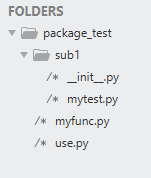
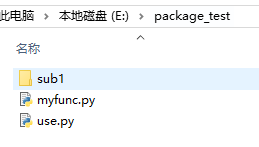

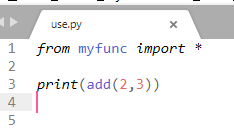
打开CMD,将目录切换到当前文件夹下,运行程序,可以发现在同目录下正常运行并且生成了缓存文件:
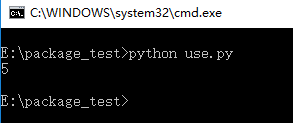

然后我们测试在不同目录下
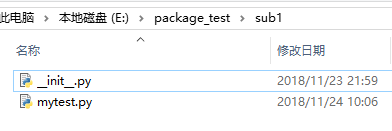
在sub1文件夹下我们因为创建了__init__.py文件,系统会认为这个文件是一个package,因此,就会尝试着加载和发现我们定义的模块:

然后再use.py中,我们发现可以正常的使用和执行了:
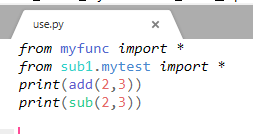
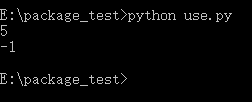
其实如果我们将__init__.py文件删除了,结果也会是一样的,同样可以运行:
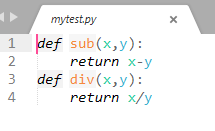

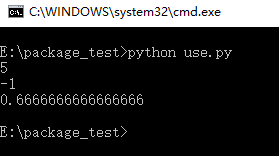
但是如果我们使用import 包名.模块名的时候就会出现问题了,我们会发现如果是在同级上可以正常使用,但是在不同的包下面,除非我们使用全称,要不然的话是不能成功的(注意:这个时候我们的包依旧没有使用__init__.py文件):
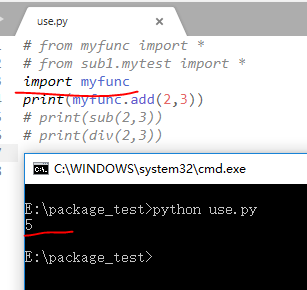
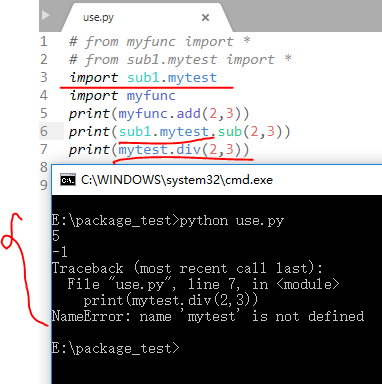
即使我们使用了__init__.py依旧会是这样:
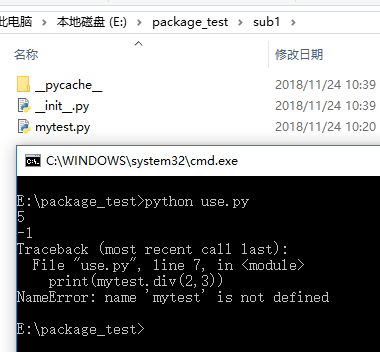
那么到底是为什么呢?
这是因为python3需要绝对路径引用,从project的根位置开始指明被引模块的位置。通用格式为:from directory import module 。如果module存在于directory1下的directory2,那么建议写成from directory1.directory2 import module,其中程序运行时根目录(mount)为directory1。使用from语句可以把模块直接导入当前命名空间,from语句并不引用导入对象的命名空间,而是将被导入对象直接引入当前命名空间。但是如果直接使用import的时候,就会使用另一个命名空间下面的函数或者变量,这个时候我们就需要使用全称来指代。
那么有没有解决办法呢,当然是有的,比如我们将子包加入到sys.path中,这样系统就能自动识别了(这个时候不需要__init__.py文件):
1 import sys 2 sys.path.append('sub1') 3 import mytest 4 print(mytest.sub(2,3))
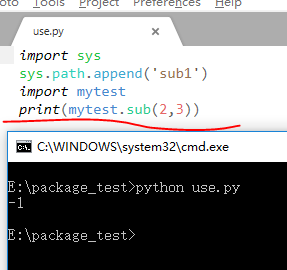
2.3、__init__.py的作用
大家可能注意到,我一直在提这个文件,那么我们可以看到在很多的大型项目之中都是有这个文件存在的,我们可以看看我们自己使用pip install XXX,从网上下载的包文件:
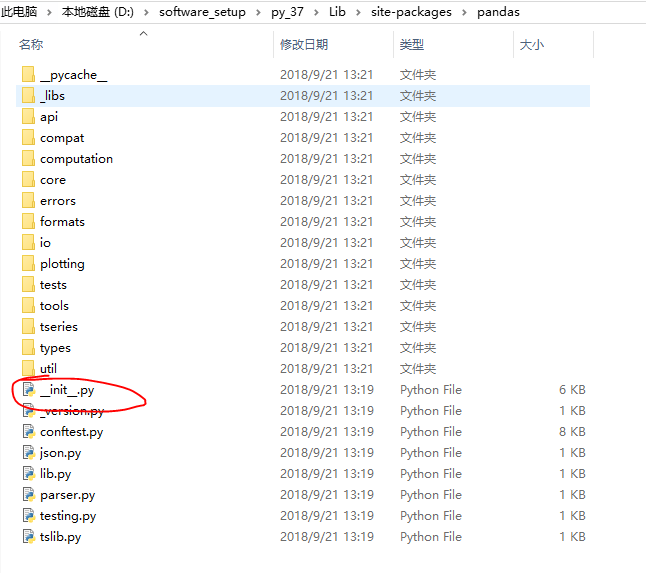
随便找一个都会发现这个文件的,并且在子目录下面也都会有这个文件的,我们看看上面的这个文件的内容,可以发现其中将自己目录下面的文件进行了一种整合方便用户直接来使用,再看看下面的子目录中的__init__.py文件有的为空,有的就是整合该目录下面的文件资源的:
1 # pylint: disable-msg=W0614,W0401,W0611,W0622 2 3 # flake8: noqa 4 5 __docformat__ = 'restructuredtext' 6 7 # Let users know if they're missing any of our hard dependencies 8 hard_dependencies = ("numpy", "pytz", "dateutil") 9 missing_dependencies = [] 10 11 for dependency in hard_dependencies: 12 try: 13 __import__(dependency) 14 except ImportError as e: 15 missing_dependencies.append(dependency) 16 17 if missing_dependencies: 18 raise ImportError( 19 "Missing required dependencies {0}".format(missing_dependencies)) 20 del hard_dependencies, dependency, missing_dependencies 21 22 # numpy compat 23 from pandas.compat.numpy import * 24 25 try: 26 from pandas._libs import (hashtable as _hashtable, 27 lib as _lib, 28 tslib as _tslib) 29 except ImportError as e: # pragma: no cover 30 # hack but overkill to use re 31 module = str(e).replace('cannot import name ', '') 32 raise ImportError("C extension: {0} not built. If you want to import " 33 "pandas from the source directory, you may need to run " 34 "'python setup.py build_ext --inplace --force' to build " 35 "the C extensions first.".format(module)) 36 37 from datetime import datetime 38 39 # let init-time option registration happen 40 import pandas.core.config_init 41 42 from pandas.core.api import * 43 from pandas.core.sparse.api import * 44 from pandas.tseries.api import * 45 from pandas.core.computation.api import * 46 from pandas.core.reshape.api import * 47 48 # deprecate tools.plotting, plot_params and scatter_matrix on the top namespace 49 import pandas.tools.plotting 50 plot_params = pandas.plotting._style._Options(deprecated=True) 51 # do not import deprecate to top namespace 52 scatter_matrix = pandas.util._decorators.deprecate( 53 'pandas.scatter_matrix', pandas.plotting.scatter_matrix, '0.20.0', 54 'pandas.plotting.scatter_matrix') 55 56 from pandas.util._print_versions import show_versions 57 from pandas.io.api import * 58 from pandas.util._tester import test 59 import pandas.testing 60 61 # extension module deprecations 62 from pandas.util._depr_module import _DeprecatedModule 63 64 json = _DeprecatedModule(deprmod='pandas.json', 65 moved={'dumps': 'pandas.io.json.dumps', 66 'loads': 'pandas.io.json.loads'}) 67 parser = _DeprecatedModule(deprmod='pandas.parser', 68 removals=['na_values'], 69 moved={'CParserError': 'pandas.errors.ParserError'}) 70 lib = _DeprecatedModule(deprmod='pandas.lib', deprmodto=False, 71 moved={'Timestamp': 'pandas.Timestamp', 72 'Timedelta': 'pandas.Timedelta', 73 'NaT': 'pandas.NaT', 74 'infer_dtype': 'pandas.api.types.infer_dtype'}) 75 tslib = _DeprecatedModule(deprmod='pandas.tslib', 76 moved={'Timestamp': 'pandas.Timestamp', 77 'Timedelta': 'pandas.Timedelta', 78 'NaT': 'pandas.NaT', 79 'NaTType': 'type(pandas.NaT)', 80 'OutOfBoundsDatetime': 'pandas.errors.OutOfBoundsDatetime'}) 81 82 # use the closest tagged version if possible 83 from ._version import get_versions 84 v = get_versions() 85 __version__ = v.get('closest-tag', v['version']) 86 del get_versions, v 87 88 # module level doc-string 89 __doc__ = """ 90 pandas - a powerful data analysis and manipulation library for Python 91 ===================================================================== 92 93 **pandas** is a Python package providing fast, flexible, and expressive data 94 structures designed to make working with "relational" or "labeled" data both 95 easy and intuitive. It aims to be the fundamental high-level building block for 96 doing practical, **real world** data analysis in Python. Additionally, it has 97 the broader goal of becoming **the most powerful and flexible open source data 98 analysis / manipulation tool available in any language**. It is already well on 99 its way toward this goal. 100 101 Main Features 102 ------------- 103 Here are just a few of the things that pandas does well: 104 105 - Easy handling of missing data in floating point as well as non-floating 106 point data. 107 - Size mutability: columns can be inserted and deleted from DataFrame and 108 higher dimensional objects 109 - Automatic and explicit data alignment: objects can be explicitly aligned 110 to a set of labels, or the user can simply ignore the labels and let 111 `Series`, `DataFrame`, etc. automatically align the data for you in 112 computations. 113 - Powerful, flexible group by functionality to perform split-apply-combine 114 operations on data sets, for both aggregating and transforming data. 115 - Make it easy to convert ragged, differently-indexed data in other Python 116 and NumPy data structures into DataFrame objects. 117 - Intelligent label-based slicing, fancy indexing, and subsetting of large 118 data sets. 119 - Intuitive merging and joining data sets. 120 - Flexible reshaping and pivoting of data sets. 121 - Hierarchical labeling of axes (possible to have multiple labels per tick). 122 - Robust IO tools for loading data from flat files (CSV and delimited), 123 Excel files, databases, and saving/loading data from the ultrafast HDF5 124 format. 125 - Time series-specific functionality: date range generation and frequency 126 conversion, moving window statistics, moving window linear regressions, 127 date shifting and lagging, etc. 128 """
下面我们看看__init__.py的作用:
__init__.py文件用于组织包(package)。当文件夹下有__init__.py时,表示当前文件夹是一个package,其下的多个module统一构成一个整体。这些module都可以通过同一个package引入代码中。__init__.py文件可以什么都不写,但如果想使用from package1 import *这种写法的话,需要在__init__.py中加上:
1 __all__ = ['file1','file2'] #package1下有file1.py,file2.py
我们看一个例子:




目前我们没有__init__.py文件,是可以运行的:

但是我们不能使用from sub2 import * 来使用。

如果使用__init__.py,在其中加入下面的语句,程序就可以正常运行了,特别是当该文件夹下的模块特别多的时候就非常有用了。
1 __all__= ['file1','file2']


三、总结
关于自定义package的导入,我们需要理解的还有很多,只有彻底的理解了其中的道理,我们才能真正的学会去使用它。